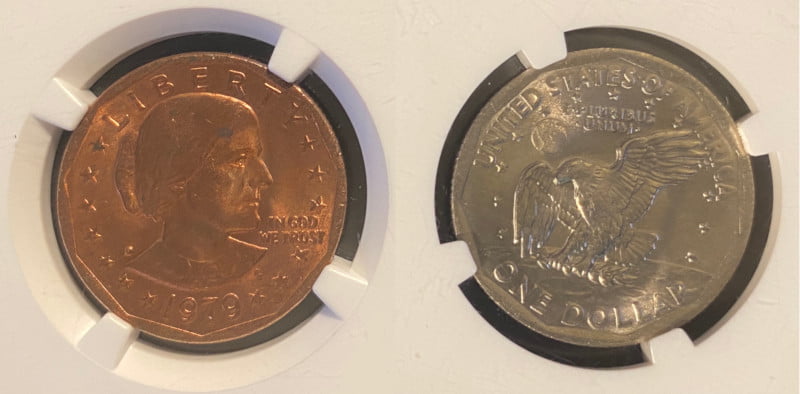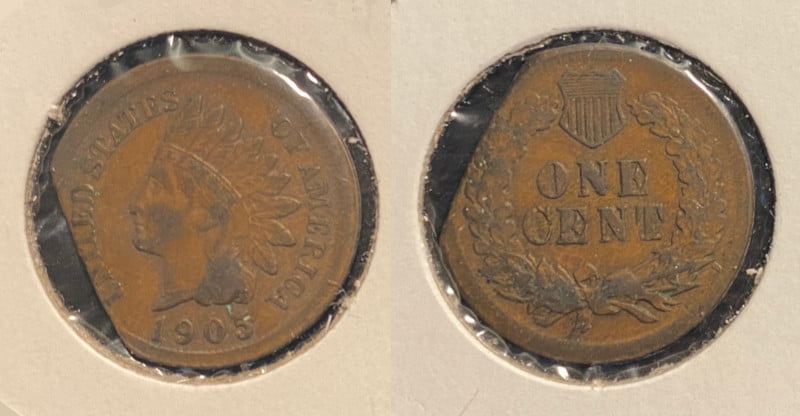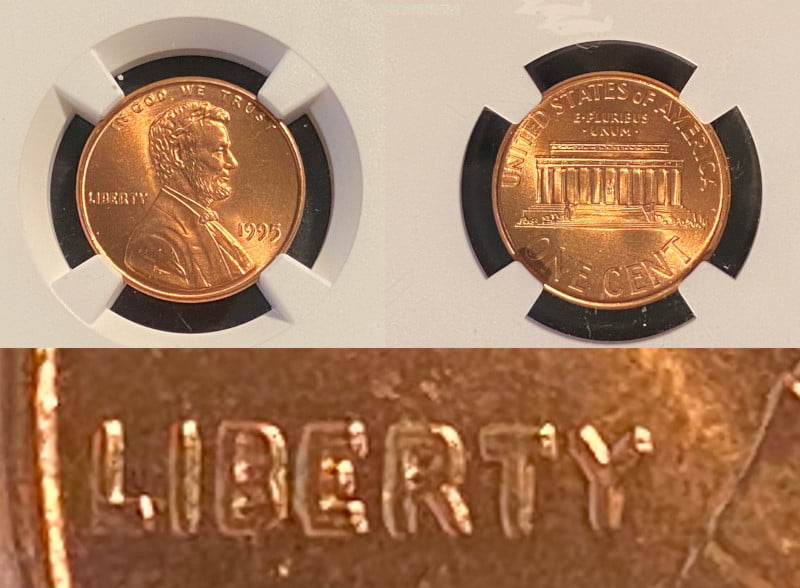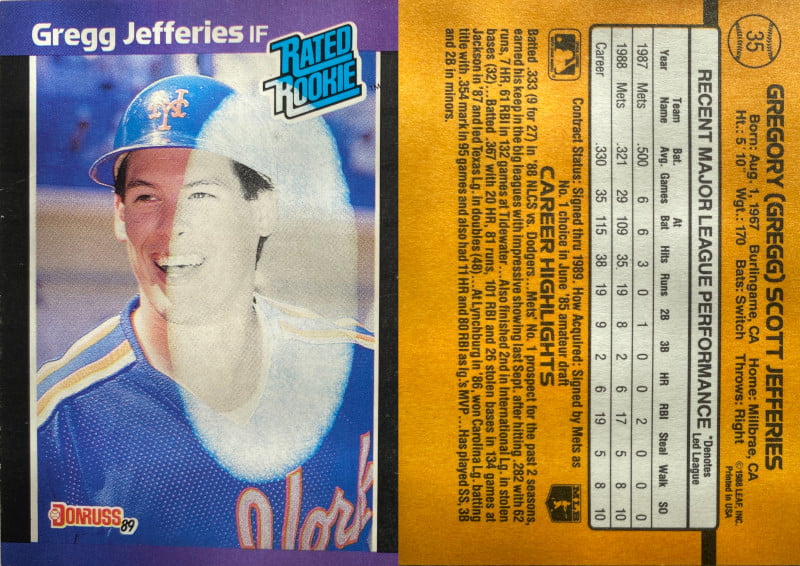As someone who collected baseball cards during the late 80s/early 90s, there were a few players who were always in demand. Mark McGwire and Jose Canseco. Ken Griffey Jr. Bo Jackson. Todd Van Poppel (no, seriously — one of my friends had a 1991 Upper Deck rookie card for the overhyped prospect who ended up with a career record of 40-52 and a 5.58 ERA and we all thought he had won Powerball).
But the guy everyone wanted a piece of was Gregg Jeffries. A can’t miss prospect for the New York Mets, Jeffries was the first player to win the Minor League Player of the Year Award from Baseball America twice (other players to have won the award include Dwight Gooden, Canseco, Frank Thomas, Derek Jeter, Mike Trout and the only other 2x winner: Andruw Jones). With his versatility in the field and undeniable talent at the plate, Jeffries started his pro career in 1987 with a bang and made an instant impact for the defending champion Mets. The hype train went into overdrive and his rookie cards became the hottest thing since Prometheus brought fire to the people.
So when I got the above Donruss card and noticed the coloring error, I thought I had hit the jackpot. Error cards can be extremely rare and valuable, so the fact that I had one for a player in such demand as Jeffries meant I’d never have to work a day in my life, right?
Obviously, things didn’t work out that way (for me or Gregg, who had a fine 14-year career, including some excellent seasons for the St. Louis Cardinals in the mid-90s, but will never be voted into the Hall of Fame). The value of error cards, and baseball cards as a whole, depend on supply and demand. And once it was clear that Jeffries wasn’t the second coming, demand plummeted and everyone moved on to the next can’t miss kid (Jeter, Chipper Jones, A-Rod… there’s always someone).
Error coins are the same way. Whether or not you have a Griffey Jr. or a Jeffries depends on supply and demand. Here are a few of the error coins I’ve collected over the years:
There are several ways error coins can come about. Among the more common and distinguishable are planchet errors, which occur when there is a problem with the blank metal alloy on which the coin is struck.
Sometimes, blank planchets will make their way into circulation. Type 1 blanks occur when a non-processed planchet simply gets mixed in with properly struck ones, while the more rare Type 2 designation indicates a blank was properly put through the striking process but something failed along the way and the disc wasn’t caught by inspectors before release. The value of these vary, but Type 1 blanks tend not to be worth that much, while Type 2 blanks can be quite valuable. For instance, I recently saw a silver dollar Type 2 planchet going for thousands on eBay.
Or sometimes the Mint will accidentally use the wrong denomination of planchet, such as a dime disc for a penny or a nickel disc for a quarter. These coins can be quite rare since the Mint usually catches these errors before they can be released to the general public. For one thing, they look funny and are quite conspicuous. For another, the weight will be off, which will alert the Mint’s quality control folks that something is up.
Or in some rare cases, the Mint will accidentally use an out-of-date planchet for a coin that has undergone a compositional change. For instance, when the Mint switched to a steel-based alloy for the Lincoln cent for a year during World War II, they mistakenly struck a small number of cents on the old copper-based discs. Then, when they switched back to the copper format the following year, they accidentally made a few on the steel alloy. These coins are extremely valuable and are among the most sought after coins in numismatics.
Another type of planchet error is the missing clad layer, which means one of the components of the metal alloy are not present (usually the outer layer). Because these types of errors are often more conspicuous than other defects, the Mint will usually catch them before they reach the general public. As such, the ones that escape their scrutiny can be quite valuable.

For instance, as we’ve covered here, a regular 1979 Susan B. Anthony dollar is about as pricey and in demand as a Van Poppel is today. Due to their ice-cold status, Anthony dollars are a good place to start for error coin collectors, as even the more rare ones are available at prices that won’t necessarily break your budget. The above Anthony dollar is a striking example of a missing clad layer that results in a cool two-toned look. I’ve also seen clad error Anthony coins where the reverse is missing the outer layer, but I greatly prefer the look on this one.
Another common error is the clipped planchet. Sometimes, there will be a mistake in the process where metal strips are fed into the blanking machine that punches out the round disks used for coin striking. Much like how baseball cards can sometimes be miscut, planchets can end up getting clipped if the punch starts too close to the edge of the metal strip.

Clipped planchet coins aren’t worth as much as some other errors. In fact, many collectors don’t even know that they are error coins. I got the above Indian Head penny at a flea market at a substantial discount because the person selling it thought it was defective or broken. I just thought it looked cool and didn’t know it was a Mint error until years later.
Doubled-dies are another notable type of error. Prior to 1997, a single planchet would often have to be struck multiple times, which meant that if the die hubs became misaligned on the subsequent strike, parts of the coin (usually the words or date) would appear blurry or offset. These errors can be hard for Mint officials to detect because they aren’t easily seen by the naked eye and weigh the same as a regular coin.

Some doubled (or even tripled or quadrupled) dies are highly sought after and extremely valuable. For instance, one of the most famous is the 1955 Doubled Die Error Penny, which as we found out in UHF, is worth a fortune. Other valuable doubled-die Lincoln cents include the 1969-S, 1917 and 1972 varieties. Post-1997 specimens are also rare, as a result of the Mint moving away from multiple striking coins. Nevertheless, these error coins remain affordable — probably because demand is almost always lower for more recent dates.
On the other hand, some doubled-die coins are fairly affordable and abundant. The above 1995 penny is one of the more common ones out there. According to Lincoln Cents, there were nearly 500,000 of these that made it to circulation, which means they are fairly affordable compared to other, more scarce varieties. For this coin, the doubling is most apparent on the word “LIBERTY,” but as with many of these coins, the error isn’t obvious unless you know to look for it.
There are plenty of other notable error coins and types out there. Some of the more in-demand ones include overstrikes (coins with new dates struck over old ones can be quite valuable, such as the 1918/7 Buffalo Nickel or the 1918/7 Standing Liberty Quarter), mint-mark mistakes (the 1982 “No P” Roosevelt Dime is one of the more famous) and even over-cleaning (the 1937-D three-legged Buffalo Nickel came about because a Mint official polished the die hubs so hard he rubbed off the buffalo’s front leg).
And one thing is for certain: No matter how advanced the production process gets, there will always be error coins. After all, everybody makes mistakes.

